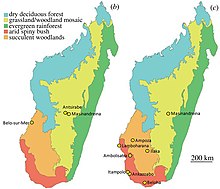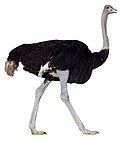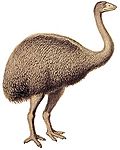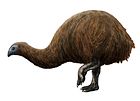| Aepyornis Temporal range: Quaternary PreꞒ Ꞓ O S D C P T J K Pg N ↓ | |
|---|---|

| |
| Aepyornis maximus skeleton and egg | |
| Conservation status | |
| Extinct (1000 AD) | |
| Scientific classification | |
| Domain: | Eukaryota |
| Kingdom: | Animalia |
| Phylum: | Chordata |
| Class: | Aves |
| Infraclass: | Palaeognathae |
| Order: | †Aepyornithiformes |
| Genus: | †Aepyornis I. Geoffroy Saint-Hilaire, 1851 |
| Type species | |
| Aepyornis maximus I. Geoffroy Saint-Hilaire 1851 | |
| Species | |
| |

| |
| Map of Madagascar showing where A. hildebrandti (b) and A. maximus (c) specimens have been found | |
| Synonyms | |
| |
Aepyornis is an extinct genus of elephant bird formerly endemic to Madagascar. The genus had two species, the smaller A. hildebrandti and the larger A. maximus, which is possibly the largest bird ever to have lived. Its closest living relative is the New Zealand kiwi. They became extinct sometime around 1000 AD, probably as a result of human activity.
Taxonomy
Brodkorb (1963) listed four species of Aepyornis as valid: A. hildebrandti, A. gracilis, A. medius and A. maximus. However, Hume and Walters (2012) listed only one species, A. maximus. Most recently, Hansford and Turvey (2018) recognized only A. hildebrandti and A. maximus.
- ?Aepyornis grandidieri Rowley 1867 nomen dubium
- Aepyornis hildebrandti Burckhardt, 1893
- Aepyornis gracilis Monnier, 1913
- Aepyornis lentus Milne-Edwards & Grandidier, 1894
- ?Aepyornis minimus
- ?Aepyornis mulleri Milne-Edwards & Grandidier, 1894
- Aepyornis maximus Hilaire, 1851
- Aepyornis cursor Milne-Edwards & Grandidier, 1894
- ?Aepyornis intermedius
- Aepyornis medius Milne-Edwards & Grandidier, 1866
- Vorombe titan (Andrews 1894) Hansford & Turvey 2018,
The nominal species Aepyornis titan Andrews, 1894, was placed in the separate genus Vorombe by Hansford and Turvey (2018), with A. ingens a synonym of titan. Aepyornis grandidieri Rowley, 1867 is an ootaxon known only from an eggshell fragment and hence a nomen dubium. Hansford and Truvey (2018) also found Aepyornis modestus a senior synonym of all Mullerornis nominal species, making modestus the epithet of the Mullerornis type species. However, later DNA studies found that Vorombe titan was indistinguishable from A. maximus, and probably represented large females of the species.
Evolution
Like the cassowaries, ostriches, rheas, emu and kiwis, the Elephant bird was a ratite; it could not fly, and its breast bone had no keel. Because Madagascar and Africa separated before the ratite lineage arose, Aepyornis and other elephant birds are thought to have dispersed and become flightless and gigantic in situ. More recently, it has been deduced from DNA sequence comparisons that the closest living relatives of elephant birds are the New Zealand kiwis, from which they were estimated to have diverged over 50 million years ago.
Description
 The skull
The skull The foot bones
The foot bonesBoth photographed at the National Museum of Natural History in Paris
The species of Aepyornis are amongst the largest birds, with weights of 235 kilograms (520 lb) estimated for A. hildebrandti and 275–1,000 kilograms (610–2,200 lb) for A. maximus, making it one of the largest, if not the largest bird to have ever lived, with the latter reaching 3 metres (9.8 ft) in height. The head bore a straight, thick conical beak, which was proportionally larger in A. hildebrandti than in A. maximus, though the heads in both birds were small relative to body size. The neck was proportionally long, with 17 cervical vertebrae. The wings were vestigial. The pelvic bones (vertebrae, ilium and pubis) were heavily fused to each other, so much so that their boundaries are difficult to discern. The hindlimb was proportionally long, with its bones being robust, with the femur in particular being very short and thick. The tibiotarsus has a prominent longitudinal ridge for muscle attachment. There is no evidence for the presence of a fourth toe or spur. The terminal toe bones (phalanges) of the foot are broad and not hooked. The females of A. maximus are suggested to have been larger than the males, as is observed in other ratites.

Ecology
Examination of brain endocasts has shown that both A. maximus and A. hildebrandti had greatly reduced optic lobes, similar to those of their closest living relatives, the kiwis, and consistent with a similar nocturnal lifestyle. A. maximus had relatively larger olfactory bulbs than A. hildebrandti, suggesting that the former occupied forested habitats where the sense of smell is more useful while the latter occupied open habitats. Elephant birds are suggested to have grown in periodic spurts rather than having continuous growth. A 2022 isotope analysis study suggested that individuals of Aepyornis hildebrandti from central Madagascar were mixed feeders that had a large (~48%) grazing component to its diet, similar to that of the living Rhea americana, while A. maximus was probably a browser. Isotope analysis of eggshells attributed to a population of A. hildebrandti from northern Madagascar suggests that this population were probably browsers rather than mixed feeders.
An embryonic skeleton of Aepyornis is known from an intact egg, around 80-90% of the way through incubation before it died. This skeleton shows that even at this early ontogenetic stage that the skeleton was robust, much more so than comparable hatchling ostriches or rheas. The eggs of Aepyornis are the largest known for any amniote, and have a volume of around 5.6–13 litres, and a length of approximately 26–40 centimetres (10–16 in) and a width of 19–25 centimetres (7.5–9.8 in). The egg is about 160 times greater volume than a chicken egg. The large size of elephant bird eggs means that they would have required substantial amounts of calcium, which is usually taken from a reservoir in the medullary bone in the femurs of female birds. Possible remnants of this tissue have been described from the femurs of A. maximus.

Extinction
The extinction of Aepyornis was likely due to human activity, especially after the arrival of humans on Madagascar. The birds were initially widespread, occurring from the northern to the southern tip of Madagascar. One theory—the blitzkrieg hypothesis—contends that humans hunted the elephant birds to extinction in a very short time after their arrival. There is indeed evidence that they were killed. However, their eggs may have been the most vulnerable point in their life cycle. A recent archaeological study found fragments of eggshells among the remains of human fires, suggesting that the eggs regularly provided meals for entire families.

The exact time period when they died out is also not certain; tales of these giant birds may have persisted for centuries in folk memory. There is archaeological evidence of Giant elephant bird (A. maximus) from a radiocarbon-dated bone at 1880 +/- 70 BP (c. 120 AD) with signs of butchering, and on the basis of radiocarbon dating of shells, about 1000 BP (= c. 1000 AD). It is thought that the A. maximus is the Malagasy legendary extinct animal called the vorompatra (pronounced [vuˈrumpə̥ʈʂ]), Malagasy for "bird of open spaces. After many years of failed attempts, DNA molecules of Aepyornis eggs were successfully extracted by a group of international researchers and results were published in 2010 in the Proceedings of the Royal Society B.
It has also been suggested that the extinction was a secondary effect of human impact due to transfer of hyperdiseases from human commensals, such as chickens and guineafowl. The bones of these domesticated fowl have been found in subfossil sites on the island (MacPhee and Marx, 1997: 188), such as Ambolisatra (Madagascar), where Mullerornis modestus and A. maximus have been reported.
See also
- Island gigantism
- Æpyornis Island, a short story by H. G. Wells that features the bird.
Footnotes
- ^ Brands, S. 2008
- ^ Grealy, Alicia; Miller, Gifford H.; Phillips, Matthew J.; Clarke, Simon J.; Fogel, Marilyn; Patalwala, Diana; Rigby, Paul; Hubbard, Alysia; Demarchi, Beatrice; Collins, Matthew; Mackie, Meaghan; Sakalauskaite, Jorune; Stiller, Josefin; Clarke, Julia A.; Legendre, Lucas J. (28 February 2023). "Molecular exploration of fossil eggshell uncovers hidden lineage of giant extinct bird". Nature Communications. 14 (1): 914. Bibcode:2023NatCo..14..914G. doi:10.1038/s41467-023-36405-3. ISSN 2041-1723. PMC 9974994. PMID 36854679.
- "Ancient DNA ends Aussie claim to kiwi origins".
- Brodkorb, P. (1963)
- Julian P. Hume; Michael Walters (2012). Extinct birds. T&AD Poyser. p. 544. ISBN 978-1408158616.
- ^ Hansford, J. P.; Turvey, S. T. (26 September 2018). "Unexpected diversity within the extinct elephant birds (Aves: Aepyornithidae) and a new identity for the world's largest bird". Royal Society Open Science. 5 (9): 181295. Bibcode:2018RSOS....581295H. doi:10.1098/rsos.181295. PMC 6170582. PMID 30839722.
- Yoder, A. D. & Nowak, M. D. (2006)
- van Tuinen, M. et al. (1998)
- Mitchell, K. J.; Llamas, B.; Soubrier, J.; Rawlence, N. J.; Worthy, T. H.; Wood, J.; Lee, M. S. Y.; Cooper, A. (23 May 2014). "Ancient DNA reveals elephant birds and kiwi are sister taxa and clarifies ratite bird evolution" (PDF). Science. 344 (6186): 898–900. Bibcode:2014Sci...344..898M. doi:10.1126/science.1251981. hdl:2328/35953. PMID 24855267. S2CID 206555952.
- Hume, J. P.; Walters, M. (2012). Extinct Birds. London: A & C Black. pp. 19–21. ISBN 978-1-4081-5725-1.
- Angst, Delphine; Buffetaut, Eric (2017), "Aepyornithiformes", Palaeobiology of Extinct Giant Flightless Birds, Elsevier, pp. 65–94, doi:10.1016/b978-1-78548-136-9.50003-9, ISBN 978-1-78548-136-9, retrieved 2 May 2023
- Torres, C. R.; Clarke, J. A. (2018). "Nocturnal giants: evolution of the sensory ecology in elephant birds and other palaeognaths inferred from digital brain reconstructions". Proceedings of the Royal Society B: Biological Sciences. 285 (1890): 20181540. doi:10.1098/rspb.2018.1540. PMC 6235046. PMID 30381378.
- ^ Chinsamy, Anusuya; Angst, Delphine; Canoville, Aurore; Göhlich, Ursula B (1 June 2020). "Bone histology yields insights into the biology of the extinct elephant birds (Aepyornithidae) from Madagascar". Biological Journal of the Linnean Society. 130 (2): 268–295. doi:10.1093/biolinnean/blaa013. ISSN 0024-4066.
- Hansford, James P.; Turvey, Samuel T. (April 2022). "Dietary isotopes of Madagascar's extinct megafauna reveal Holocene browsing and grazing guilds". Biology Letters. 18 (4): 20220094. doi:10.1098/rsbl.2022.0094. ISSN 1744-957X. PMC 9006009. PMID 35414222.
- Balanoff, Amy M.; Rowe, Timothy (12 December 2007). "Osteological description of an embryonic skeleton of the extinct elephant bird, Aepyornis (Palaeognathae: Ratitae)". Journal of Vertebrate Paleontology. 27 (sup4): 1–53. doi:10.1671/0272-4634(2007)27[1:ODOAES]2.0.CO;2. ISSN 0272-4634.
- ^ Hawkins, A. F. A. & Goodman, S. M. (2003)
- Pearson and Godden (2002)
- "Malagasy Dictionary and Encyclopedia : Vorompatrana".
- "Malagasy Dictionary and Encyclopedia : Vorona".
- "Malagasy Dictionary and Encyclopedia : Fatrana".
- Ghosh, Pallab (2010)
- Goodman, S. M. & Rakotozafy, L. M. A. (1997)
References
- BBC News (25 March 2009). "One minute world news". Day in Pictures. BBC News. Archived from the original on 27 March 2009. Retrieved 26 March 2009.
- Brands, Sheila J. (1989). "The Taxonomicon : Taxon: Order Aepyornithiformes". Zwaag, Netherlands: Universal Taxonomic Services. Archived from the original on 21 April 2008. Retrieved 21 January 2010.
- Brodkorb, Pierce (1963). "Catalogue of Fossil Birds Part 1 (Archaeopterygiformes through Ardeiformes)". Bulletin of the Florida State Museum, Biological Sciences. 7 (4): 179–293.
- Cooper, A.; Lalueza-Fox, C.; Anderson, S.; Rambaut, A.; Austin, J.; Ward, R. (8 February 2001). "Complete Mitochondrial Genome Sequences of Two Extinct Moas Clarify Ratite Evolution". Nature. 409 (6821): 704–707. Bibcode:2001Natur.409..704C. doi:10.1038/35055536. PMID 11217857. S2CID 4430050.
- Davies, S.J.J.F. (2003). "Elephant birds (Aepyornithidae)". In Hutchins, Michael (ed.). Grzimek's Animal Life Encyclopedia. Vol. 8 Birds I Tinamous and Ratites to Hoatzins (2 ed.). Farmington Hills, MI: Gale Group. pp. 103–104. ISBN 978-0-7876-5784-0.
- Ghosh, Pallab (10 March 2010). "Ancient eggshell yields its DNA". BBC News. Archived from the original on 23 March 2010. Retrieved 23 April 2010.
- Goodman, Steven M. (1994). "Description of a new species of subfossil eagle from Madagascar: Stephanoaetus (Aves: Falconiformes) from the deposits of Ampasambazimba". Proceedings of the Biological Society of Washington (107): 421–428.
- Goodman, S. M.; Rakotozafy, L. M. A. (1997). "Subfossil birds from coastal sites in western and southwestern Madagascar". In Goodman, S. M.; Patterson, B. D. (eds.). Natural Change and Human Impact in Madagascar. Washington, DC: Smithsonian Institution Press. pp. 257–279. ISBN 978-1-56098-683-6.
- Hawkins, A. F. A.; Goodman, S. M. (2003). Goodman, S. M.; Benstead, J. P. (eds.). The Natural History of Madagascar. University of Chicago Press. pp. 1026–1029. ISBN 978-0-226-30307-9.
- Hay, W. W.; DeConto, R. M.; Wold, C. N.; Wilson, K. M.; Voigt, S. (1999). "Alternative global Cretaceous paleogeography". In Barrera, E.; Johnson, C. C. (eds.). Evolution of the Cretaceous Ocean Climate System. Boulder, CO: Geological Society of America. pp. 1–47. ISBN 978-0-8137-2332-7.
- Mlíkovsky, J. (2003). "Eggs of extinct aepyornithids (Aves: Aepyornithidae) of Madagascar: size and taxonomic identity". Sylvia. 39: 133–138.
- Pearson, Mike Parker; Godden, K. (2002). In search of the Red Slave: Shipwreck and Captivity in Madagascar. Stroud, Gloucestershire: The History Press. ISBN 978-0-7509-2938-7.
- van Tuinen, Marcel; Sibley, Charles G.; Hedges, S. Blair (1998). "Phylogeny and Biogeography of Ratite Birds Inferred from DNA Sequences of the Mitochondrial Ribosomal Genes". Molecular Biology and Evolution. 15 (4): 370–376. doi:10.1093/oxfordjournals.molbev.a025933. PMID 9549088.
- "Vorompatra". 2005. Archived from the original on 27 October 2009.
- Yoder, Anne D.; Nowak, Michael D. (2006). "Has Vicariance or Dispersal Been the Predominant Biogeographic Force in Madagascar? Only Time Will Tell". Annual Review of Ecology, Evolution, and Systematics. 37: 405–431. doi:10.1146/annurev.ecolsys.37.091305.110239.
| Taxon identifiers | |
|---|---|
| Aepyornis | |


